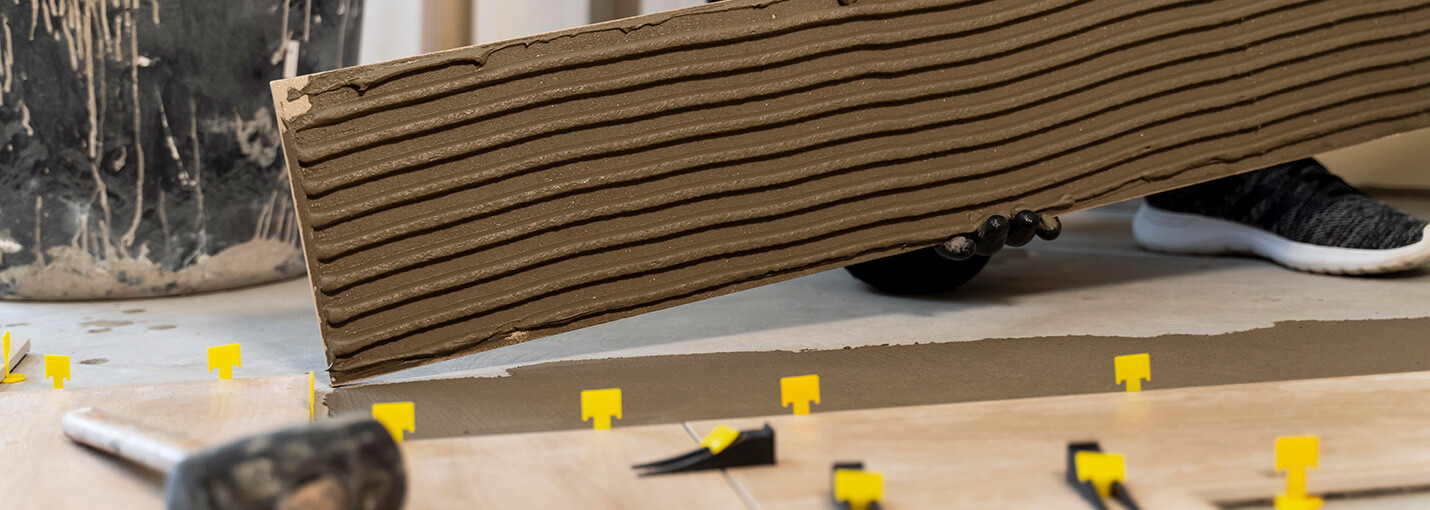Best Way to Seal Asbestos Tile
Asbestos is a naturally occurring mineral that is known for its heat resistance and durability. It was once extensively used in construction materials such as floor tiles. Though the benefits were recognized, the detrimental health effects have led to widespread concerns.
!
If you believe that you were exposed to asbestos, even as a child, speak to a healthcare provider about tests and screening to help diagnose lung-scarring and screen for asbestos-related diseases.
Asbestos-containing floor tiles, if not managed properly, can pose serious health and legal risks.
This guide will explore the best way to seal asbestos tiles. Meanwhile, we’ll be taking into consideration the need for sealing, the prevalence of asbestos in buildings, health dangers, legal implications, and the advantages of selling asbestos-free spaces.
With that in mind, let’s take a closer look at everything you need to know about asbestos and the best way to seal tiles that contain it.
The Need to Seal Asbestos Tiles
The primary reason for sealing asbestos tiles is to prevent the release of harmful asbestos fibers into the air. Asbestos-containing materials, when damaged or disturbed, can release tiny fibers that, if inhaled, can lead to respiratory issues, including lung cancer, asbestosis, and mesothelioma. Sealing these tiles effectively contains the fibers, reducing the risk of exposure and potential health hazards.
Asbestos has no taste or smell.
You may not know you’re breathing it.

Asbestos may appear harmless. But that won’t mean anything positive. The substance will degrade over time due to age, wear, or even renovations. These can cause the microscopic fibers to be released into the air. If you are removing or working around asbestos, it’s important to take the necessary safety precautions.
“The overall evidence suggests there is no safe level of asbestos exposure.”Source: National Cancer Institute (NIH)1 |
The Ubiquity of Asbestos in Buildings
Asbestos was widely used in construction throughout the 20th century due to its fire-resistant properties and durability. As a result, many older buildings, especially those built before the 1980s, contain asbestos-containing materials, including floor tiles. The prevalence of asbestos in buildings underscores the importance of proper management and sealing of such materials to protect the occupant.
Aside from floor tiles, asbestos would also be found in ceiling tiles, insulation, pipe insulation, and roofing materials. For example, asbestos in the ceiling would often be used for acoustic qualities while also being present in attics, wall cavities, and around pipes for the purpose of heat resistance.
 |
| Nearly every building constructed before the mid-1980s contained asbestos products and building materials. |
 |
Legal Dangers of Asbestos Exposure from your Property
Apart from the health risks, there are legal implications surrounding asbestos exposure. Governments worldwide have recognized the dangers of asbestos and have implemented regulations to protect people from exposure. Improper management of asbestos-containing materials, including floor tiles, can lead to legal troubles for property owners.
Failing to address asbestos-related concerns in accordance with local regulations can result in fines and legal liabilities. In the complex landscape of property ownership and management, asbestos can be more of a legal obstacle than anything.
That’s why there are regulatory frameworks in place to safeguard individuals, communities, and the environment from these dangers. Non-compliance can lead to severe legal consequences. Property owners have a legal duty of care to provide safe environments for both occupants and visitors.
The responsibilities include identifying and managing potential asbestos-containing materials within the property. Failing to fulfill it can result in liabilities should individuals be exposed to asbestos fibers and later deal with the health issues associated with it.
In an occupational setting, safety protocols are stringent and must be followed. Failure to do so can endanger the health of workers, while opening the door to possible legal action.
“Some asbestos fibers may bypass…your body’s natural defenses…and lodge deep within your lungs. Those fibers can remain in place for a very long time and may never be removed.”Source: American Lung Association |

The Process of Sealing Asbestos Tiles
Sealing asbestos tiles involves encapsulating them to prevent the release of fibers. The reality is that it’s worth hiring a professional rather than doing this yourself. Even though it may be expensive compared to the latter, professionals have the proper equipment, training, and expertise to safely sealing off asbestos tiles.
Professional abatement contractors follow strict procedures when it comes to the testing and removal of asbestos.
Here’s how the process of (safely) sealing your asbestos tile works:
Step 1: Preparation for Safe Sealing
It’s important to utilize the proper gear when sealing asbestos tiles. That’s why the following equipment is needed:
An N95 respirator.
Protective clothing such as disposable coveralls with a hood to prevent fibers from adhering to clothing.
Disposable gloves to protect hands from coming into contact with asbestos-containing materials.
Disposable boot covers: Prevent cross-contamination by wearing disposable boot covers.
Step 2: Securing the Work Area
Sealing asbestos tiles should be done in a controlled environment to prevent the spread of fibers. The following precautions that need to be followed including the following:
Isolating the work area using plastic sheeting and tape to create a containment zone.
Sealing off the HVAC systems to prevent the spread of fibers throughout the property.
Step 3: Cleaning the Area
This should be done thoroughly to minimize the risk of fiber release. This includes wet cleaning and the use of a HEPA vacuum.
Step 4: Applying the Sealant
You want to apply the sealant that is designed for encapsulating asbestos-containing materials. This includes preparing the sealant according to the manufacturer’s instructions, applying the first coast with a brush or sprayer, and allowing it to dry.
Step 5: Adding additional coats
Apply any additional coats using the same process. Multiple coats improve the effectiveness of the encapsulation. Be sure to dry between coats.
Step 6: Final inspection and monitoring
A final inspection and monitoring should be done – especially a visual inspection. Regular monitoring should also be implemented in order to see if the sealing was a success while looking out for any deterioration.
The Advantages of Selling Asbestos-Free
For property owners, there are several compelling advantages to ensuring that spaces are asbestos-free:
Occupant safety
The safety and well-being of occupants should always be top priority. Providing an asbestos-free environment assures tenants, employees, and visitors that their health is valued.
Property value
Buildings free from asbestos hazards are more attractive to potential buyers and tenants. A property with a clean bill of health is likely to command a higher market value.
Reduced Liability
By proactively sealing or removing asbestos tiles, property owners can reduce their liability exposure. Thus, it minimizes the risk of legal actions and associated costs.
Ethical responsibility
Taking steps to create a safe living or working environment is an ethical responsibility. It showcases a commitment to the welfare of individuals who utilize the space.
“Generally, those who develop asbestos-related diseases show no signs of illness for a long time after exposure.”Source: National Cancer Institute (NIH)2 |
Final Thoughts
Sealing asbestos tiles is a critical step in ensuring the safety of occupants, protecting property value, and minimizing legal liabilities. The health and legal dangers associated with asbestos exposure are serious, making property management of asbestos-containing materials essential.
“All forms of asbestos are carcinogenic to humans.” 3
By understanding the need for sealing, acknowledging the prevalence of asbestos in buildings, recognizing health and legal risks, and appreciating the benefits of asbestos-free spaces, property owners can take proactive measures to create a safer and more secure environment for everyone.
AsbestosClaims.Law
Asbestos claims aren’t just a day in the office for Justinian C. Lane.
They’re a mission.
In the past, workers exposed to asbestos were kept in the dark about the dangers of asbestos exposure. Among those workers were Justinian’s grandparents and his own father.
Unfortunately, they were also kept in the dark about the compensation options available to them, such as asbestos lawsuits and trust funds. In their later years, they died from asbestos-related cancers.
Because no one in Justinian’s family knew their options, they never received any compensation for the death of their loved ones.
Today, we’re working to turn the tide.
Significant compensation may be available to you if you have contracted an asbestos-related illness or injury. This includes workers as well as family members who have been exposed.
Compensation is your key to receiving the medical treatment you need, funding asbestos removal services, and maintaining your physical well-being.
Want to know one of the quickest and easiest ways to receive compensation? Let us talk to you about asbestos trust claims. This option can often avoid lawsuits altogether.
We want to hear your story, and more importantly, we want to bring redemption to it.
Need help filing a claim? No problem, you can email us at [email protected].
Would you rather talk over the phone? Simply call or text us, at (206) 455-9190.
You won’t pay a penny to us unless you receive money first, so there’s no risk.
In addition to legal claims, veterans disability, social security and employment protection like workers compensation, FELA and The Jones Act for maritime workers, there are asbestos trusts that have been set up to compensate those harmed by asbestos without having to file a lawsuit.
The dangers of asbestos used to be an industry-guarded secret kept from suffering people like Justinian’s family. Not anymore. We’re bringing you the truth.
We’ve created numerous resources to help answer your questions and empower you with the information you need to know and act on.
Our website has a wealth of information dedicated to things like health and safety, asbestos testing, asbestos removal, and legal information about compensation for asbestos injuries.
Are you a visual learner? No problem!
Our YouTube page has infographics, an asbestos history series, and other helpful resources for you to check out!
| Not sure where or when you were exposed to asbestos? Let W.A.R.D. help you! The Worldwide Asbestos Research Database (W.A.R.D) is the largest asbestos information database, period. If you need answers related to specific locations, products, or what type of compensation may be available to you due to asbestos exposure, W.A.R.D. is the place to start. |
Working with us is risk-free. Unless you receive compensation money, there are NO FEES! Speak to us about asbestos litigation today.
References:
https://www.tandfonline.com/doi/abs/10.1080/15298668791385075
1 National Cancer Institute (NIH), Asbestos Fact Sheet.
2 National Cancer Institute (NIH), Asbestos Fact Sheet.
3 IARC Working Group on the Evaluation of Carcinogenic Risks to Humans. Arsenic, metals, fibres, and dusts. IARC Monographs on the Evaluation of Carcinogenic Risks to Humans. 2012 ;100(Pt C):11-465. PMID: 23189751.